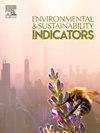Link of dragonflies and damselflies with the aquatic environment is differently expressed in adult and larval stages
IF 5.4
Q1 ENVIRONMENTAL SCIENCES
引用次数: 0
Abstract
Aquatic insects like dragonflies and damselflies link the aquatic and terrestrial world through their life-cycle. Adults and larvae are frequently regarded as indicators of good environmental quality. The relationship between adults and the water quality in a nearby water system is not well known as well as to what extent adults reflect the presence of their larvae in that water system. To explore these relationships, ideally adults and larvae should be recorded at the same time. In a Dutch citizen science project, adult Odonata were recorded while collecting aquatic macroinvertebrates in 364 sampling events in 2023.
Regression analyses showed that the presence of adult dragonflies was weakly correlated with the presence of their larvae in a nearby water system, while the presence of adult damselflies was a much better indicator. Damselfly larvae were associated with a moderate to reasonable biological water quality and dragonfly larvae with reasonable to good. Higher vegetation cover coincided with the presence of adult Odonata, but vegetation cover was insignificant to their larvae. Abiotic conditions were more important for larvae than biotic variables. Dragonfly larvae were better indicators of good water quality than damselfly larvae and adult Odonata were not at all associated with water quality in the nearby water system. However, adult Odonata do indicate the presence of aquatic vegetation in a nearby water system. Since volunteers frequently sampled other waters than professionals, public available data of these recordings can be very beneficial for water managers to know more about water quality in their areas.
求助全文
约1分钟内获得全文
求助全文
来源期刊

Environmental and Sustainability Indicators
Environmental Science-Environmental Science (miscellaneous)
CiteScore
7.80
自引率
2.30%
发文量
49
审稿时长
57 days
 求助内容:
求助内容: 应助结果提醒方式:
应助结果提醒方式:


